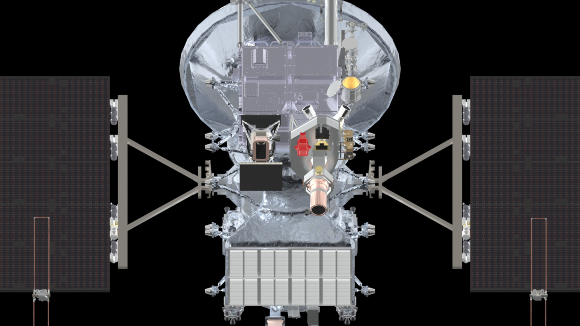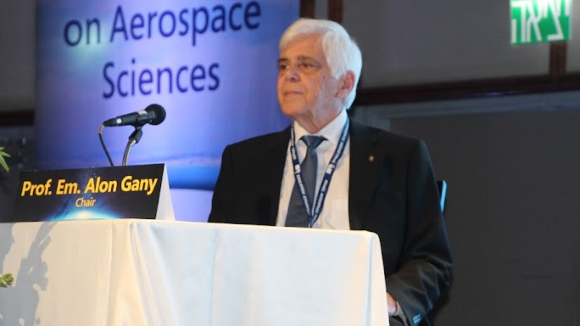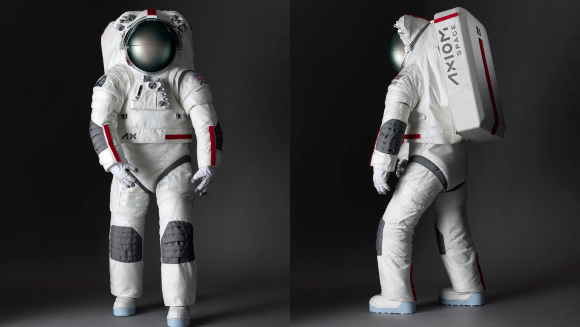Getting your Trinity Audio player ready...
A prestigious award for an Israeli propulsion researcher
The American Institute of Aeronautics and Astronautics (AIAA) has selected Israeli researcher Alon Gany to receive its prestigious Wyld Propulsion Award for 2025. Gany was recognized for his “pioneering contributions to the study of propulsion using metal-containing fuels, energetic materials, hybrid rockets, ramjet and scramjet engines, and for excellence in educating generations of propulsion experts.”
"It’s exciting and gratifying to receive this international recognition," Gany told the Davidson Institute website. Those who have received this award in the past are among the best in the field, and this recognition is truly at the highest level."
Gany, 80, is Professor Emeritus at the Faculty of Aerospace Engineering at the Technion, where he earned all his academic degrees, completing his doctorate in 1975. Following a postdoctoral fellowship at Princeton University, he began his academic career as a faculty member at the Technion. Over the years, Gany’s research has spanned multiple areas of propulsion, leading to several significant breakthroughs.
Early in his career, Gany focused on solid rocket fuels. Like all fuels, these systems require an oxidizer for combustion. In liquid-fueled rockets—such as SpaceX's Starship, which runs on methane (CH₄)—the oxidizer is typically liquid oxygen, mixed with the fuel in the combustion chamber. In solid-propellant rockets, the fuel is generally a polymer, with the oxidizer dispersed throughout as an oxygen-containing salt. Aluminum powder is often added to improve combustion.
A key challenge is preventing the aluminum particles from clustering into large aggregates, which burn more slowly and reduce engine performance. "We found that using relatively large aluminum particles, 20-30 microns (0.02-0.03 mm) in diameter, creates fewer clusters than smaller ones, about 5-6 microns," Gany explained. "Today, the industry uses these larger particles." His team also developed a method to coat aluminum crystals with nickel or iron, enhancing ignition and combustion.
Gany has also made significant contributions to ramjet propulsion—jet engines that operate at supersonic speeds above Mach 2, twice the speed of sound. "We characterized combustion data for different fuels and speeds in these engines," he said.
"The extensive data we provided is still used today in engine design." Gany and his colleagues later transitioned to scramjet engines, which operate at even higher speeds above Mach 5, where the airflow in the combustion chamber remains supersonic. "We were the first in the world to replicate Mach 5.5 flight conditions using static solid-fuel tests, years ahead of our time. Our findings are still relevant in the field today."
Another field in which Gany has made significant contributions is hybrid rocket propulsion, which combines solid fuel with a liquid or gaseous oxidizer. "We developed methods to significantly increase the fuel's burn rate, enhancing the rocket’s thrust," he noted.
Gany and his team also achieved breakthroughs in hydrogen supply for fuel cells. These cells generate clean electricity from hydrogen oxidation through an electrochemical process, offering much higher energy density than batteries. Fuel cells were the primary power source for Apollo spacecraft, although the infamous Apollo 13 accident resulted from an oxygen tank explosion that fed these cells. However, hydrogen storage and transport present challenges.
Gany’s research explored the production of hydrogen on-demand via reactions between aluminum and water—a method that, while impractical for spacecraft, could prove invaluable for submarines or ships with unlimited access to water.
"Our approach overcomes the outer layer of aluminum that prevents oxidation," Gany explained. "This technique yields ten times more electricity per kilogram of aluminum than batteries of the same weight. From my experience, our method is the most efficient, cost-effective, and practical. We have patented it and are now seeking investors to commercialize the technology."
In recent years, Gany has also ventured into underwater ramjet engines. "The idea is a derivative of atmospheric ramjets, but these engines use water instead of air, enhancing energy efficiency and extending the operational range."
Throughout his career, Gany has published around 150 scientific papers and contributed about 20 book chapters, most co-authored with his research students. He has supervised about 100 master's and doctoral students—an impressive figure compared to other researchers—and has taught thousands of undergraduates.
"I’ve trained generations of students and experts, many of whom now work in leading industries across these fields," he said with pride. "I’m deeply grateful to everyone I’ve worked with over the years—students, technical staff, and visiting scientists." Naturally, some of Gany’s work has also involved collaborations with defense industries. "We generally focus on basic, non-classified research rather than building systems, but I provide consulting when needed for specific projects."
The significance of Gany’s work is evident in Israel’s current military operations, spanning from rocket propulsion to naval systems. "Einstein said that Israel’s future and ability to exist would depend on its scientists and engineers," Gany concluded. "The country’s need for talented scientists and engineers is critical."
The Israeli coating en route to Jupiter
Last week, NASA successfully launched the unmanned Europa Clipper spacecraft to study Jupiter’s icy moon, Europa. The mission’s primary goal is to explore whether the liquid ocean, believed to lie beneath Europa’s outer ice layer, could harbor conditions suitable for life.
Launched from Florida aboard SpaceX’s Falcon Heavy rocket, the spacecraft is expected to enter orbit around Jupiter in 2030, following gravity-assist flybys of Mars and Earth to boost its speed. Its mission around Jupiter is planned to last about three years, during which it will conduct approximately fifty flybys close to Europa, some as near as 25 kilometers from its surface.
These flybys will allow the spacecraft to explore Europa’s surface using a variety of instruments, providing unprecedented information about the ice mantle and what lies beneath.
5 View gallery


One of the keys to mission success: calibrating the thermal camera using the Israeli coating. The body of the Europa Clipper spacecraft, with the E-THEMIS instrument highlighted in red
(Photo: NASA)
A key tool for this mission was developed by the Israeli company Acktar, which specializes in producing black, light-absorbing coatings for a wide range of applications—from electronics and vehicles to medical devices. Founded 30 years ago in Kiryat Gat, Acktar has become a leading provider of specialized coating components for space missions, where coatings must withstand extremely harsh conditions.
One of the crucial instruments aboard the Europa Clipper is E-THEMIS, a scanner operating in far-infrared wavelengths. “Essentially, it’s similar to a thermal camera used by plumbers but with far more advanced capabilities—it can penetrate below the surface and measure temperature differences with extremely high sensitivity,” explained Dina Katzir, Acktar’s Chief Technology Officer, in an interview with the Davidson Institute website.
The device was developed for NASA by a research team at the University of Arizona. “Our role was to produce a black coating that would allow the instrument to be calibrated—a crucial step in making it operational for the mission,” Katzir explained. “This time, the challenge was to create a coating that could withstand Jupiter's extreme radiation environment while being extremely thin, only a few microns (thousandths of a millimeter) thick.”
Thanks to Acktar’s assistance in designing and developing the complex instrument, Katzir was invited to add her signature alongside the project leaders’ names, which were engraved on a tiny memory plaque attached to the device, now en route to Jupiter. “It’s an incredible feeling to be involved in such projects,” Katzir concluded.
This is not Acktar’s first involvement with a mission to Jupiter. The European Space Agency’s JUICE mission, which is currently en route to explore Jupiter and its moons, incorporates components coated by Acktar, along with other Israeli-made parts. The European Space Agency published last week the first images from the mapping conducted by the EUCLID space telescope, launched last year to study dark matter and dark energy—a project that also incorporates optical components developed with Acktar’s participation.
Starship: Sixth test on the horizon
SpaceX marked a major milestone last week with the fifth launch test of the Starship system, successfully landing the massive Super Heavy booster on the specialized catch tower during the first attempt. The tower’s arms, referred to as "Mechazilla" or simply the "chopsticks," caught the booster as it hovered vertically near the tower. The success even surprised those within SpaceX, with company President Gwynne Shotwell tweeting, "I don't know what to say!" along with a video of the dramatic landing.
Another significant achievement was the completion of the mission by the spacecraft itself, referred to simply as the "Ship." After a suborbital flight to the Indian Ocean, the Ship successfully re-entered the atmosphere and executed a precise landing maneuver above the designated splashdown site before plunging into the sea with a large explosion.
The Ship demonstrated improved landing accuracy compared to the previous test and sustained less heat damage to its flaps, thanks to structural enhancements made by SpaceX. The following day, SpaceX founder and CEO Elon Musk tweeted, "Just inspected the Starship booster, which the arms have now placed back in its launch mount. Looks great! A few outer engine nozzles are warped from heating & some other minor issues, but these are easily addressed."
The fifth test launch took place shortly after SpaceX obtained the required license from the Federal Aviation Administration (FAA), following a publicized dispute between Musk and the agency. An additional benefit of the license is that it also covers the upcoming sixth test flight, provided it follows the same plan.
SpaceX's fifth Starship test
(Video: Reuters / SpaceX)
Although SpaceX has not released specific details about the upcoming test, current information suggests it will closely follow the scenario of the fifth flight and could take place within the next six weeks. The company has already completed static fire tests on both the booster and spacecraft for the next launch, in preparation for a quick turnaround.
The next major objective for SpaceX is to land the Ship back at the launch site. This challenge will require placing the Ship in orbit around Earth—a feat not yet achieved—and involves firing the engines in space for both orbital insertion and atmospheric re-entry. If these hurdles are overcome, the company plans to conduct at least four test flights in 2025, including a demonstration of in-space refueling. This step is critical toward using Starship as a crewed lunar lander for NASA’s Artemis program.
The new lunar suits
Last week, Axiom Space unveiled the new spacesuits developed for the astronauts set to land on the Moon as part of NASA's Artemis program. Designed in collaboration with the renowned fashion house Prada, the suits were presented for the first time at the International Astronautical Congress (IAC), held this year in Milan, Italy.
Axiom secured the contract with NASA for developing these suits two years ago, receiving approximately $230 million for the initial phase of the project. The total contract value could exceed $3 billion as the suits are delivered for future space missions.
According to Axiom, the suits feature advanced materials and structural improvements that offer astronauts greater mobility on the lunar surface, along with enhanced safety. The company announced that the suits will provide insulation from the intense heat at the Moon’s south pole and protection from the extreme cold in the region’s permanently shadowed craters. Equipped with complete life-support systems, the suites are designed to enable eight hours of spacewalks and activity on the lunar surface.
The suits are tailored for both male and female astronauts, accommodating a wide range of body sizes and customized to fit each astronaut's specific measurements. They have already undergone rigorous testing in vacuum chambers to ensure durability and reliability. In 2025, Axiom, NASA, and SpaceX will conduct additional tests to assess the suits' performance in conditions simulating lunar activities.
Get the Ynetnews app on your smartphone:








